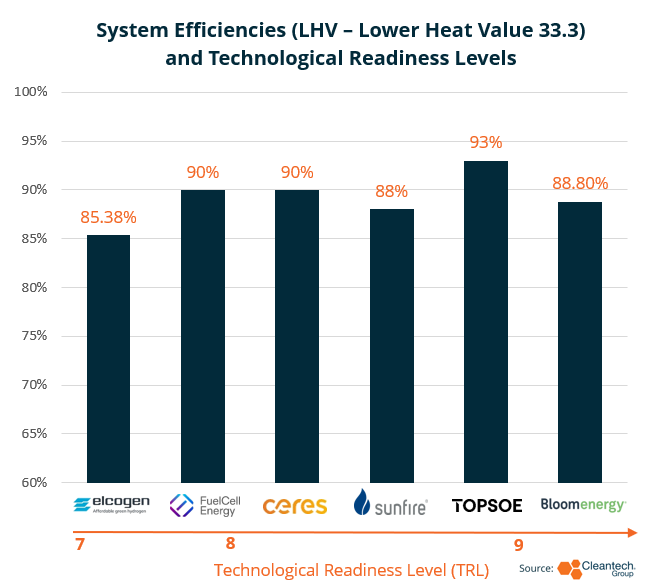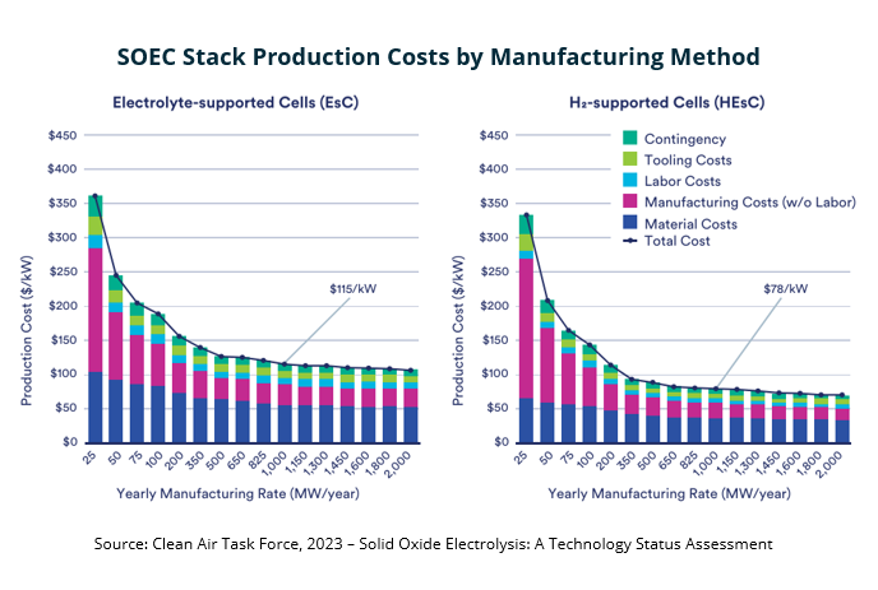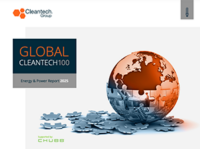High Efficiency, High Costs: Is There Space for Solid Oxide Electrolyzers in the Hydrogen Industry?
Solid oxide electrolyzers (SOECs) are emerging to be a hot topic in the world of energy. They use a solid ceramic material to split water into hydrogen and oxygen at extremely high temperatures (600°C to 850°C). Due to the high operating temperature, they are also highly efficient, hitting energy efficiency levels between 80-100%. These levels are significantly higher than other dominant electrolyzers in the market such as Alkaline (AEL), Proton Exchange Membrane (PEM), and Anion Exchange Membrane (AEM), which usually have efficiency levels of 58-75%.
However, while SOEC efficiency is unparalleled, the high costs and technical challenges associated with SOECs make them suitable only for specific, high-value use cases.

Data: Extracted from company websites and company contacts as of 1/2/2025
Note: LHV 33.3 refers to the lower heating value of hydrogen (33.3 kWh/kg), used to calculate SOEC efficiency by measuring the energy content of the hydrogen produced. It represents the usable energy without accounting for water vaporization.
The Promise of SOECs
SOECs are distinguished by their high efficiency, often achieving Higher Heat Value (HHV) efficiency above 100%. This means that the energy output of the process can exceed the energy input, a rare and valuable trait in energy production technologies. This high efficiency results in the production of high-purity hydrogen, which is crucial for industries that require stringent quality standards, such as the synthetic fuels sector.
Furthermore, SOECs can use waste heat and steam from industrial processes, making them even more efficient and cheaper to run. This is a win for both cost savings and sustainability in various industries.
Where SOECs Really Shine
- Synthetic Fuels: SOECs are particularly suitable for producing syngas (a mix of hydrogen and carbon monoxide) for synthetic fuels. The high purity of hydrogen means less refining is needed, making the whole process cheaper and more efficient. This is promising for the Sustainable Aviation Fuel (SAF) industry, which also has growing regulatory and production support. Offtake agreements such as Norsk e-fuels with Sunfire, and Airbus with Genvia, are already in place.
- Steelmaking: The steel industry can cut CO2 emissions by 80-90% using SOECs, as hydrogen can replace carbon in the iron ore reduction process. The high-temperature environment and the availability of waste heat in steel plants align well with the operational needs of SOECs, further increasing efficiency. Projects like GrinHy with Sunfire and Salzgitter, and Ceres’ SteelCell development with Doosan, are key in demonstrating the viability of this use case.
- Nuclear Power Plants: SOECs can be integrated into nuclear plants to produce hydrogen more efficiently using the excess heat from the plants. This not only boosts plant efficiency but also enhances safety by reducing the need for external hydrogen supplies. The integration of hydrogen production within nuclear plants can also help in balancing the energy grid, providing a flexible and reliable energy source. Companies like FuelCell Energy and Bloom Energy are exploring this potential.
Corporate engagement through pilot demonstration plants and offtake agreements is crucial for scaling up production from kilowatts (kW) to megawatts (MW). Such initiatives are already underway, indicating a growing interest and investment in this technology.
The Roadblocks
Despite their benefits, the promise of SOECs comes at a high cost—two to three times more expensive than other electrolyzers. They also face technical challenges due to their high operating temperatures, which can lead to faster wear-and-tear and higher upfront costs. While high operating temperatures can help mitigate performance loss, they also induce thermal stress, increasing the risk of stack failure through electrolyte cracking or seal breakage. SOECs can run at full load for about 2.5 years, while other electrolyzers can last 4-8 times longer.
Furthermore, SOEC technology relies heavily on electricity costs because it needs a lot of energy to run the high-temperature electrolysis process. It is more cost-effective in places where electricity is cheap or there is plenty of affordable renewable energy. On the other hand, it struggles in areas with high electricity costs, unstable power, or small-scale setups. SOECs need steady high temperatures and stable power to work well, so regions with unreliable renewable energy sources like solar or wind can have issues unless they use energy storage solutions or smart grid management to smooth out the power supply.
Scaling production from kW to MW would drastically reduce manufacturing and material costs and savings in total stack cost can be 67% to 77% when comparing kW to MW scaled technologies. However, only a few innovators such as Bloom Energy and Topsoe have stacks at large scales, which are essential to exhibit technical maturity and long-term viability to investors.

Innovating for the Future
Looking ahead, the focus for SOEC technology is on technical innovation and cost reduction. ‘Next-generation’ SOEC technology aims to address the current limitations by improving the durability of materials, optimizing design, and enhancing manufacturing processes. Some examples are:
Manufacturing Innovation:
- Mitsubishi Heavy Industries: Uses tubes instead of sheets for stack manufacturing – simplifies gas sealing and flow management, leading to improved performance reliability
- FuelCell Energy: Uses disc-shaped stacks to cut costs by repurposing DVD production machinery; stacks are 95% recyclable
- Elcogen: Automating stack assembly to speed up production and lower costs
Material and Design Innovation:
- Ceres: Uses a Gadolinium-doped ceria electrolyte, which allows for lower temperature operation, and stack uses less nickel – improves durability and reduces costs
- Elcogen: Operates at a lower temperature, allowing the use of cheaper components such as stainless steel instead of specialized alloys
- Bloom Energy: Cutting out deoxygenation units to simplify system design – reduces costs and maintenance needs
Integration Innovation:
- Topsoe: Integration of electrolyzer technology with ammonia and methanol production, leveraging expertise through their catalyst business
- Sunfire: Plants running on a combination of alkaline and SOEC electrolyzers, providing a strong advantage for the power-to-liquid and e-fuels markets
These advancements are paving the way for SOECs to scale up and become more affordable. As the energy landscape shifts, SOECs could play a crucial role in a sustainable and efficient hydrogen economy. However, realizing this potential will depend on continued innovation and corporate partnerships.



